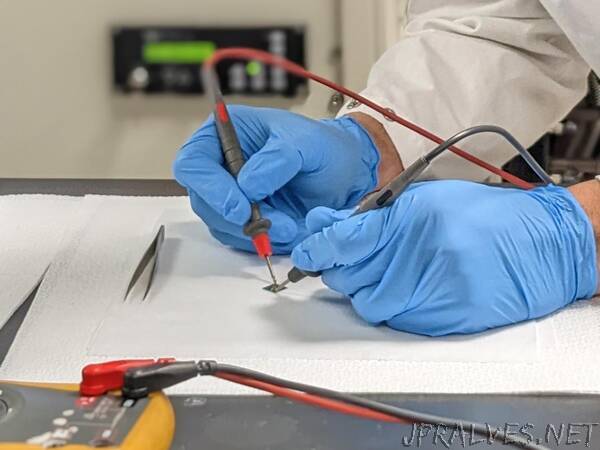
“Advances in computing power over the decades have come thanks in part to our ability to make smaller and smaller transistors, a building block of electronic devices, but we are nearing the limit of the silicon materials typically used. A new technique for creating 2D oxide materials may pave the way for future high-speed electronics, according to an international team of scientists.
“One way we can make our transistors, our electronic devices, work faster is to shrink the distance electrons have to travel between point A and B,” said Joshua Robinson, professor of materials science and engineering at Penn State. “You can only go so far with 3D materials like silicon — once you shrink it down to a nanometer, its properties change. So there’s been a massive push looking at new materials, one of which are 2D materials.”
The team, led by Furkan Turker, graduate student in the Department of Materials Sciences, used a technique called confinement hetroepitaxy, or CHet, to create 2D oxides, materials with special properties that can serve as an atomically thin insulating layer between layers of electrically conducting materials.
“Now we can create essentially the world’s thinnest oxides — just a few atoms thick,” Turker said. “That allows you to bring conducting layers closer together than ever without letting them touch. This enables the formation of an ultrathin barrier between conducting layers, which is essential for the fabrication of next-generation electronic devices, such as diodes or transistors.”
In laboratory tests, the oxides showed good properties for use in 2D/3D stacked materials called heterostructures that can enable electrons to travel vertically through the structure instead of horizontally like conventional devices.
This shortens the distance the electrons must travel to create a flow of electricity, important for building future high-speed devices that operate at gigahertz and terahertz frequencies, the scientists said. They reported their findings in the journal Advanced Functional Materials.
“That’s the real motivation behind this — can we create something that’s an insulator that is essentially only a few atoms thick and still be able to control the electronic properties of the entire stack,” Robinson said. “And because it’s much shorter that means our electrons can go from A to B faster and they don’t have to increase their speed at all.”
The research draws on previous work at Penn State using confinement heteroepitaxy to create atomic thin metals, which is now being explored as part of the Center for Nanoscale Science at Penn State, a National Science Foundation Materials Research, Science and Engineering Center (MRSEC).
The process involves heating silicon carbide to a high temperature, causing a thin layer of silicon to evaporate from the surface and leaving behind carbon that rearranges to form graphene — a 2D version of carbon, essentially forming a protective layer over the material.
Importantly, the graphene and silicon carbide interface is only partially stable. This means when the scientists poke holes in the graphene and evaporate pure metal powders onto the surface at high temperatures, the metals are pulled into the holes in a capillary action-like process, the scientists said.
Those metals are conducting, or even superconducting, but can be made into insulators via oxidation — the same process that causes metals to rust when exposed to air.
In the new work, the scientists created additional holes or patterns in the material and heated it again, allowing gas to interact with the metal layer inside.
“It really is like Legoland — you can get all sorts of ‘Lego’ colors and stack them on top of each other, and the same is with these 2D materials,” Robinson said. “In this work, we create our stack of ‘Legos’ and then change the color of the ‘Lego’ in the middle by slowly squeezing in a little oxygen, without removing anything else.”
The process allows scientists to stabilize traditionally 3D materials like gallium oxide in 2D form.
When growing gallium oxide by traditional methods, the material initially will ball or clump together and does not result in a uniform film until the material is several nanometers thick, the scientists said.
The CHet technique produces a graphene cap that sandwiches the materials in and results in molecularly thin layers, the scientists said.
“The properties of the graphene control everything underneath it,” Turker said. “The number one thing this paper demonstrates is that the graphene is a gatekeeper and by being able to control the properties of our gatekeeper, we can tune layers underneath it to form a 2D metal, or oxide, by which we can manipulate the electronic properties of the 2D/3D heterostructure.”
Further work will involve growing materials on top of the graphene to create the whole device structure and studying the junctions between those layers and potential defects in the materials.
Also contributing from Penn State were Susan Sinnott, professor and head of the Department of Materials Science and Engineering, Maxwell Wetherington, staff scientist in the Materials Research Institute, Chengye Dong, postdoctoral scholar, Furkan Turker and Stephen Holoviak, graduate students, and Zachary Trdinich and Eric Lawson, undergraduates.
Also contributing to the research from McMaster University are: Nabil Bassim, professor of materials science and engineering, Gopi Krishnan, postdoctoral fellow, Caleb Whittier, doctoral candidate, and Hesham El-Sherif, then a doctoral student at McMaster University
The Air Force Office of Scientific Research, the U.S. Department of Energy, the National Science Foundation.”
